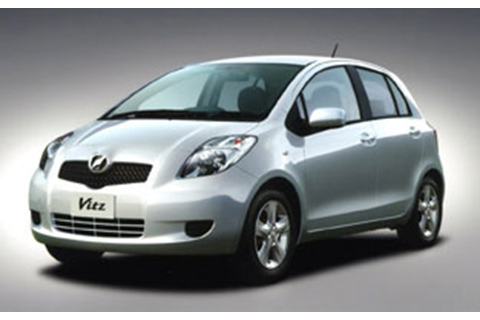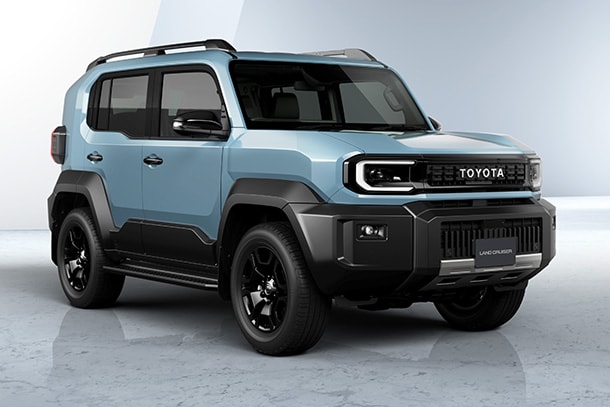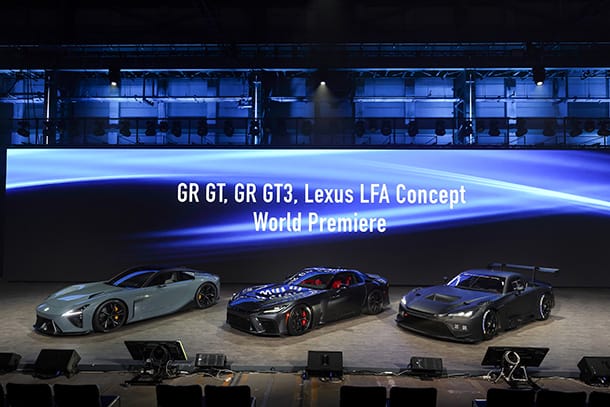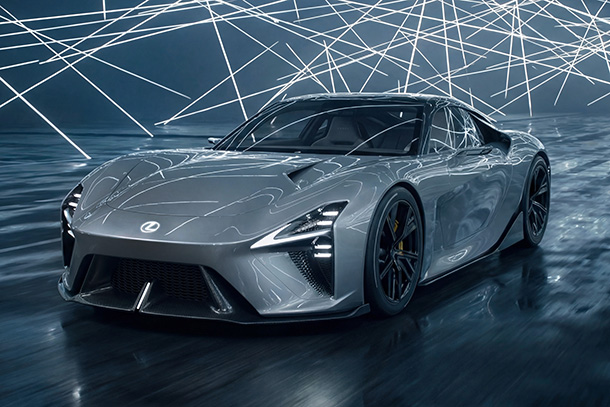Tokyo―TOYOTA MOTOR CORPORATION (TMC) announced today the nationwide sales launch of the completely redesigned Vitz through "Netz Toyota" dealers.
The popular first-generation Vitz was launched in 1999 and triggered an expansion of the compact car market. Offering both an interior space that comfortably seats four adults in an easy-to-handle package and excellent basic performance, the first-generation Vitz created a standard for compact cars.
Based on a "Proud of My Compact" development concept, the second-generation Vitz is designed to provide a performance level that is one above that of ordinary compact cars. The new Vitz offers comprehensive improvements in basic performance features such as driving and safety, as well as in riding comfort, functionality and quality. In the words of Chief Engineer Kousuke Shibahara, "We designed the new Vitz so that owners would be able to experience the outstanding quality the moment they grip the steering wheel and think contently to themselves 'I'm glad I bought a Vitz.'"
-

- Vitz F (1.0-liter front-wheel-drive vehicle) (with options)
A newly developed platform and a superior package create a roomy interior, along with a nimble and stable driving feel, an advanced and elegant interior, and the highest safety and environmental performance in its class*. The embodiment of high quality, the new Vitz cuts a new standard for next-generation compact cars.
*Comparison with vehicles of similar engine displacement
The new Netz channel that started operations in May of last year aims to meet the challenge of a new channel structure under the theme of "Channels for the 21st Century." To promote the originality of the sales channel, beginning with the new Vitz, all major vehicle series handled by the Netz channel will feature an original logo using the letter "N" from Netz.
Based on the Toyota design theme, "Vibrant Clarity", the exterior design evokes a sense of solid strength and vigor, while the advanced interior offers simple elegance, immediately visible upon opening the door.
Generous cabin space and large luggage capacity have been simultaneously achieved inside compact exterior dimensions through a superior package made possible by a newly developed platform.
Versatile seat arrangements and ample storage space deliver a high level of utility.
A newly designed suspension and brakes make for brisk yet stable driving performance and a comfortable ride. Linear acceleration and a smooth driving feel have been achieved through the use of the new Super CVT-i (Continuously Variable Transmission-intelligent).
The GOA construction has been further evolved by incorporating the concept of compatibility, which considers the fate of both vehicles in situations where passenger vehicles of differing weights collide, as a means of promoting crash safety for both cars in a collision with a vehicle of up to the 2-ton range. Collision tests at 55km/h were conducted, the highest testing speed used for Toyota vehicles so far.
Seat structures that incorporate the WIL (Whiplash Injury Lessening) concept, designed to further reduce stress on the neck during low-speed impacts from the rear, are incorporated in the structural design of the front seats, achieving class leading levels of safety performance.
Eco-VAS (Eco-Vehicle Assessment System), Toyota's original comprehensive environmental impact assessment system, was implemented for the first time in the new Vitz, resulting in a reduction of environmental impact throughout the entire life cycle of the vehicle from production to disposal.
All front-wheel-drive vehicles achieve emission levels 75% lower than 2005 standards under the Ministry of Land, Infrastructure and Transport's Approval System for Low-emission Vehicles and boast fuel efficiency that exceeds by five percent the level called for by Japanese 2010 fuel efficiency standards.
Sales Channels
- Sales outlets
- "Netz Toyota" dealers
- Monthly sales target
- 10,000 units
Sporty exterior with a sense of presence and an advanced and elegant interior
- The exterior design is based on the concept of "Powerful Simplicity."
- An integrated-bumper configuration, with bold transversal lines extending from the windshield to the front bumper, results in a powerful front view.
- A mono-form silhouette with a tilted windshield and supple character lines flowing from the front to the rear, produce a dynamic side view on a vehicle body with compact dimensions.
- A forward-leaning rear shape and a wide wheel tread create a firmly grounded and stable posture.
Interior design based on the concept of "Vivid Simplicity"
- The novel vertical center cluster design creates ample legroom.
- The generous cabin space is emphasized by the use of a bright, looped molding that continuously flows from the ceiling to the pillars and door armrests.
- Doors can be locked and unlocked by simply having the key on one's person. The Smart Entry and Start System uses a push button to start the engine.
- Also featured is an automatic air-conditioner with a pollen-removal mode that, with the operation of a switch, filters out pollen, dust and other impurities from the air around the faces of the vehicle occupants (the first of its kind).
Superior package achieves generous cabin space inside compact exterior dimensions
- A newly developed platform provides for class-leading legroom of 880mm between the front and rear seats.
- By using rear seats with seatbacks that fold in a 60:40 split and can be tumbled forward for increased luggage space (in the 1.3F (2WD), X and U (2WD) grades), seatbacks that fold in a 60:40 split and can be folded flat (in the 1.3F (4WD) and U (4WD) grades) or a single seatback that folds forward for increased luggage space (in the B, 10F and RS grades), the new Vitz offers demand-matching seat arrangement versatility.
Superior driving performance that achieves a comfortable and stable driving experience
- The 1.0-liter, 1.3-liter and 1.5-liter engines with VVT-i (Variable Valve Timing–intelligent) simultaneously achieve high performance and high fuel efficiency.
- The Super CVT-i achieves high fuel efficiency as well as a quiet and responsive drive (front-wheel-drive vehicles).
- A newly developed ultra-compact torque converter realizes a smooth drive and high fuel efficiency.
- Neutral control improves fuel efficiency by semi-releasing the clutch when the vehicle is stopped (with the shift lever in "D")
- Traction control improves responsiveness to accelerator operation.
- The newly developed suspension provides superior maneuverability and driving stability, as well as a comfortable ride.
- The newly developed brake ensures excellent braking responsiveness and superior braking force.
- The "Intelligent Package" (to become available in April 2005) will use the new Toyota Intelligent Idling Stop System to achieve the highest fuel efficiency level within the class.
High safety performance, even under more stringent collision conditions
- The GOA construction has been further evolved to create a body structure that effectively absorbs collision impact.
- To further improve its collision safety performance, the new Vitz was subjected to omni-directional, vehicle-to-vehicle collision tests at 55km/h (a 5km/h increase over the test conditions Toyota had been using). Thanks to the use of a body structure that effectively absorbs the collision impact by means of effectively positioned front side members and floor cross members, Toyota's independent targets for survival space and dummy injury were all satisfied.
- The pedestrian-injury-lessening body structure has been further evolved to further reduce pedestrian head injuries, and meets pedestrian head-protection standards set to come into effect from September 2005, thus pursuing the world's top level of protection in its class.
- Seat structures with stronger seat frames and possessing greater seatback give, which incorporate the WIL (Whiplash Impact Lessening) concept and are based on analyses using THUMS (Total Human Model for Safety), are incorporated in the structural design of the front seats to reduce stress on the neck during low-speed impacts from the rear.
Class leading environmental features
- Eco-VAS (Eco-Vehicle Assessment System), Toyota's original comprehensive environmental impact assessment system, was implemented for the first time in the new Vitz, efficiently reducing environmental impact.
- Goals were set for reducing substances of concern at all stages, from initial development to disposal, resulting in a reduction of environmental impact throughout the entire life cycle of the vehicle.
- LCA (life-cycle assessment) has been implemented and emissions of CO2 and other atmospheric pollutants have been reduced, not just during the use stage but also over the entire life cycle of the vehicle, from manufacture through to disposal.
- All front-wheel-drive vehicles achieve emission levels 75% lower than 2005 standards under the Ministry of Land, Infrastructure and Transport's Approval System for Low-emission Vehicles, and boast fuel efficiency that exceeds by five percent the level called for by Japanese 2010 fuel efficiency standards (fuel efficiency standards specified by the Law Concerning the Rational Use of Energy), thus qualifying for incentives under the Japanese government's Green Taxation System.
Welcab
Welcab Lift-up Front Passenger Seat model
Designed to make use easier for elderly and disabled passengers, these models (Type A, Type B) feature a lift-up front passenger seat.
Welcab Rotating and Sliding Passenger's Seat model
Designed for elderly and disabled people, these models (Type A, Type B) come with a front passenger's seat that features both a rotating and sliding function.
Welcab Friendmatic Seat model
This model (Type I, Type II) allows for the installation of a specialized driver's seat and devices that facilitate driving, enabling persons without use of their legs to drive with only their hands.
Vitz Specifications (2WD)
| Grade | CVT | Manual Transmission | ||||||||
|---|---|---|---|---|---|---|---|---|---|---|
| U | X | F | B | RS | ||||||
| 1.3L | 1.5L | 1.3L | 1.0L | 1.0L | 1.5L | |||||
| Powertrain | 2WD (FF) | |||||||||
| Length | (mm) | 3,750 | 3,800 | |||||||
| Width | (mm) | 1,695 | ||||||||
| Height | (mm) | 1,520 | ||||||||
| Wheelbase | (mm) | 2,460 | ||||||||
| Track | Front | (mm) | 1,470 | 1,480 | 1,460 | |||||
| Rear | (mm) | 1,460 | 1,470 | 1,450 | ||||||
| Minimum turning radius | (m) | 4.7 | 4.4 | 5.5 | ||||||
| Ground clearance | (mm) | 145 | ||||||||
| Curb weight | (kg) | 1,030 | 1,050 | 1,010 | 980 | 1,060 | 1,030 | |||
| Engine | Model | 2SZ-FE | 1NZ-FE | 2SZ-FE | 1KR-FE | 1NZ-FE | ||||
| Engine type | In-line 4-cylinder DOHC | In-line 3-cylinder DOHC | In-line 4-cylinder DOHC | |||||||
| Displacement | (cc) | 1296 | 1496 | 1296 | 996 | 1496 | ||||
| Bore x stroke | (mm) | 72.0 x 79.6 | 75.0 x 84.7 | 72.0 x 79.6 | 71.0 x 83.9 | 75.0 x 84.7 | ||||
| Compression ratio | 11.0 | 10.5 | 11.0 | 10.5 | 10.5 | |||||
| Maximum output | 64 (87) / 6,000 | 81 (110) / 6,000 | 64 (87) / 6,000 | 52 (71) / 6,000 | 81 (110) / 6,000 | |||||
| Maximum torque | 116 (11.8) / 4,000 | 141 (14.4) / 4,400 | 116 (11.8) / 4,000 | 94 (9.6) / 3,600 | 141 (14.4) / 4,400 | |||||
| Fuel consumption | (km/L) | 19.6 | 18.6 | 21.5 | 22.0 | 18.6 | 17.6 | |||
| Major measures to improve fuel efficiency | Continuously variable valve timing mechanism, electric power steering system, charge control, Super CVT-i, torque converter with a lock-up function and (for vehicles with "Intelligent Package") Idling Stop System | Continuously variable valve timing mechanism, electric power steering system and charge control | ||||||||
| Fuel supply system | EFI (Electronic fuel injection) | |||||||||
| Fuel capacity | (L) | 42 | ||||||||
| Steering | Rack and pinion | |||||||||
| Suspension | front | MacPherson strutted-type coil springs | ||||||||
| rear | Torsion beam type with coil springs | |||||||||
| Brakes | front | 14 inch Ventilated disc | 15 inch Ventilated disc | |||||||
| rear | Leading / trailing | 15 inch Disc | ||||||||
- NOTES
- 1) Specifications do not include option considerations; 2) Fuel consumption measured in the Japanese 10 - 15 test cycle
Vitz Specifications (4WD)
| Grade | Automatic Transmission | ||||
|---|---|---|---|---|---|
| U | F | ||||
| 1.3L | |||||
| Powertrain | 4WD | ||||
| Length | (mm) | 3,750 | |||
| Width | (mm) | 1,695 | |||
| Height | (mm) | 1,540 | |||
| Wheelbase | (mm) | 2,460 | |||
| Track | Front | (mm) | 1,470 | 1,480 | |
| Rear | (mm) | 1,460 | 1,470 | ||
| Minimum turning radius | (m) | 4.7 | 4.4 | ||
| Ground clearance | (mm) | 125 | |||
| Curb weight | (kg) | 1,110 (AT) | 1,100 (AT) | ||
| Engine | Model | 2NZ-FE | |||
| Engine type | In-line 4-cylinder DOHC | ||||
| Displacement | (cc) | 1298 | |||
| Bore x stroke | (mm) | 75.0 x 73.5 | |||
| Compression ratio | 10.5 | ||||
| Maximum output | 64 (87) / 6,000 | ||||
| Maximum torque | 120 (12.2) / 4,400 | ||||
| Fuel consumption | (km/L) | 16.0 | |||
| Major measures to improve fuel efficiency | Continuously variable valve timing mechanism, electric power steering system and charge control and torque converter with a lock-up function | ||||
| Fuel supply system | EFI (Electronic fuel injection) | ||||
| Fuel capacity | (L) | 42 | |||
| Steering | Rack and pinion | ||||
| Suspension | front | MacPherson strutted-type coil springs | |||
| rear | Torsion beam type with coil springs | ||||
| Brakes | front | 14 inch Ventilated disc | |||
| rear | Leading / trailing | ||||
- NOTES
- 1) Specifications do not include option considerations; 2) Fuel consumption measured in the Japanese 10 - 15 test cycle





